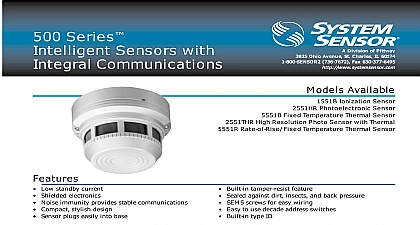System Sensor Meeting NFPA 72-2010 and DOD Intelligibility Requirements

File Preview
Click below to download for free
Click below to download for free
File Data
| Name | system-sensor-meeting-nfpa-72-2010-and-dod-intelligibility-requirements-6892047531.pdf |
|---|---|
| Type | |
| Size | 843.62 KB |
| Downloads |
Text Preview
October 2010 Paper NFPA 72 2010 DOD Intelligibility Requirements Meeting NFPA 72 2010 and DOD Intelligibility Requirements 72 2010 includes a new section outlining intelligibility requirements voice evacuation systems The inclusion of these requirements will changes in how these systems are designed and installed intelligibility is a relatively new concept to fire and life safety System Sensor is providing this whitepaper to help designers installers understand the concept of intelligibility and how it applies notification systems new terminology included in the code how to which spaces must meet intelligibility requirements and factors affect intelligibility In addition it will focus on applying the code and Key Terms Defined 72 2010 defines intelligibility as the quality or condition of being 3.3.124 It defines intelligible as capable of being understood clear 3.3.126 Those familiar with the code will recognize this is a slight change from NFPA 72 2007 which defined intelligibility audible voice information that is distinguishable and understandable definitions can be ambiguous What is clear and understandable to person may not be to another Therefore it is important to know how to design for and predict intelligibility for each installation based on objective factors Perhaps an easier way to look at intelligibility is as measure of the effectiveness of speech or the percentage of a message is understood correctly are several other key terms to be aware of in order to properly understand apply intelligibility requirements Acoustically Distinguishable Space is a term added to NFPA 72 2010 Establishing ADSs is foundational planning an intelligible system Speech Transmission Index STI or is the most common quantitative methodology for measuring using a test meter It is a weighted average of the response to modulation frequencies The Common Intelligibility Scale CIS created to map all quantitative intelligibility measurement methods to same scale so that all different results can be compared Communication System ECS is an NFPA term that refers large site wide notification systems while Mass Notification System is a military term used for the same types of systems Intelligibility relate to the voice evacuation system portion of a fire or ECS system Sensor Advanced Ideas Advanced Solutions Meeting NFPA 72 2010 and DOD Intelligibility Requirements That Affect Intelligibility an intelligible system can be complicated by a variety of factors the properties of the speaker chosen have some impact on the of a system most factors have to do with the occupancy itself while important speaker choice will not always ensure intelligibility are some of the main factors that impact intelligibility Ratio ratio is a comparison of the sound level that is being by the speaker to the ambient or background noise in the room order to help achieve the needed intelligibility it is important to ensure speaker sound output is 10 to 15 dB over ambient noise NPFA 72 2010 18 calls for an average 15 dB over ambient Going any higher this results in diminishing returns in terms of improving intelligibility if a better intelligibility score is needed more speakers should be at lower tap settings as opposed to increasing the sound output on the speakers Figure 1 shows when installing speakers each time the power output number of installed speakers is doubled the sound output increases 3 dB Each time the distance between the listener and sound source is there is a 6 dB loss in loudness dBA dBA dBA 1 Signal to Noise Ratio Response voice evacuation speakers ideally should have a frequency range 150 and 11,000 Hertz Hz because this is the frequency range that adult voice produces Underwriters Laboratories UL requires and tests a narrower frequency range between 400 and 4,000 Hz because this closer to the average range in which humans can hear sound efficiently measuring frequency response it is important for frequency to be as as possible to produce the most intelligible sound The flatter the response the frequency range the better the speaker intelligibility will be Sensor Advanced Ideas Advanced Solutions Meeting NFPA 72 2010 and DOD Intelligibility Requirements Distortion average person can detect as little as 2 percent distortion when listening sound output Once the sound output reaches 15 percent distortion it is non intelligible UL allows up to 20 percent distortion over the 710 3,550 Hz However this would make for a poor sounding speaker the least amount of measurable distortion is desired are many factors that affect harmonic distortion such as tolerance of message generator and amplifier loading of the audio amplifiers load vs power or mechanical factors including wires touching the cone the speaker excessive voltage drop in the speaker line vibration caused poor installation and damaged speakers In addition all manufactured has distortion built into it All of these different factors build on other and have a cumulative effect on intelligibility is the persistence of a sound through echoes and reflections the initial sound source is removed These echoes and reflections the main reason why it is often difficult and sometimes impossible to a required intelligibility score in certain environments like large areas with very reflective surfaces If echoes are spaced too closely the sound cannot be clearly distinguished by the listener so reverberation is key to achieving the intelligibility score desired of the main factors that affect reverberation include room size the properties of the surfaces in the space the orientation of the and the sound output of the speaker and Listener Abilities is great variation in the human element relating to intelligibility around the abilities of the talker and listeners Talker abilities that affect intelligibility would include accents dialects diction frequency voice etc Listener ability is the sensitivity of a listener hearing in the Code previously located in the Annex of NFPA 72 2007 intelligibility have been written into the body of the code for NFPA 72 2010 18 and 24 For intelligibility Chapter 24 states that the system be capable of reproducing intelligible messages in accordance with 18 Sensor Advanced Ideas Advanced Solutions Meeting NFPA 72 2010 and DOD Intelligibility Requirements noted earlier ADS is an important new term added to the NFPA 72 2010 An ADS is emergency communication system notification zone subdivision thereof that might be an enclosed or otherwise physically space or that might be distinguished from other spaces due to environmental or use characteristics such as reverberation time ambient sound pressure level section 3.3.2 Some factors that might distinguish spaces within a given area include floor wall and materials ceiling heights and ambient noise conditions to the NFPA Code 18.4.10.1 each ADS is determined by the designer during the planning and design phase of any system In each ADS shall be identified as requiring or not requiring voice 18.4.10.2 Finally when intelligibility is required by the AHJ assignments have to be submitted for review and approval 18.4.10.3 of the main goals of the new wording around ADSs and the intelligibility in NFPA 72 2010 is to help avoid over designing and testing to meet intelligibility requirements in areas deemed on criteria identified in the ADS assignation phase Layout and Design information in Chapter 24 provides requirements for laying out an voice evacuation system for an ECS Section 24.4.1.2.2.1 requires The speaker layout of the system shall be designed to ensure intelligibility audibility shall first be determined by ensuring that all areas in the have the required level of audibility The design shall incorporate speaker placement to provide intelligibility order to lay out speakers for a voice evacuation system there are several one needs to know about the speakers and the environment in which will be p


